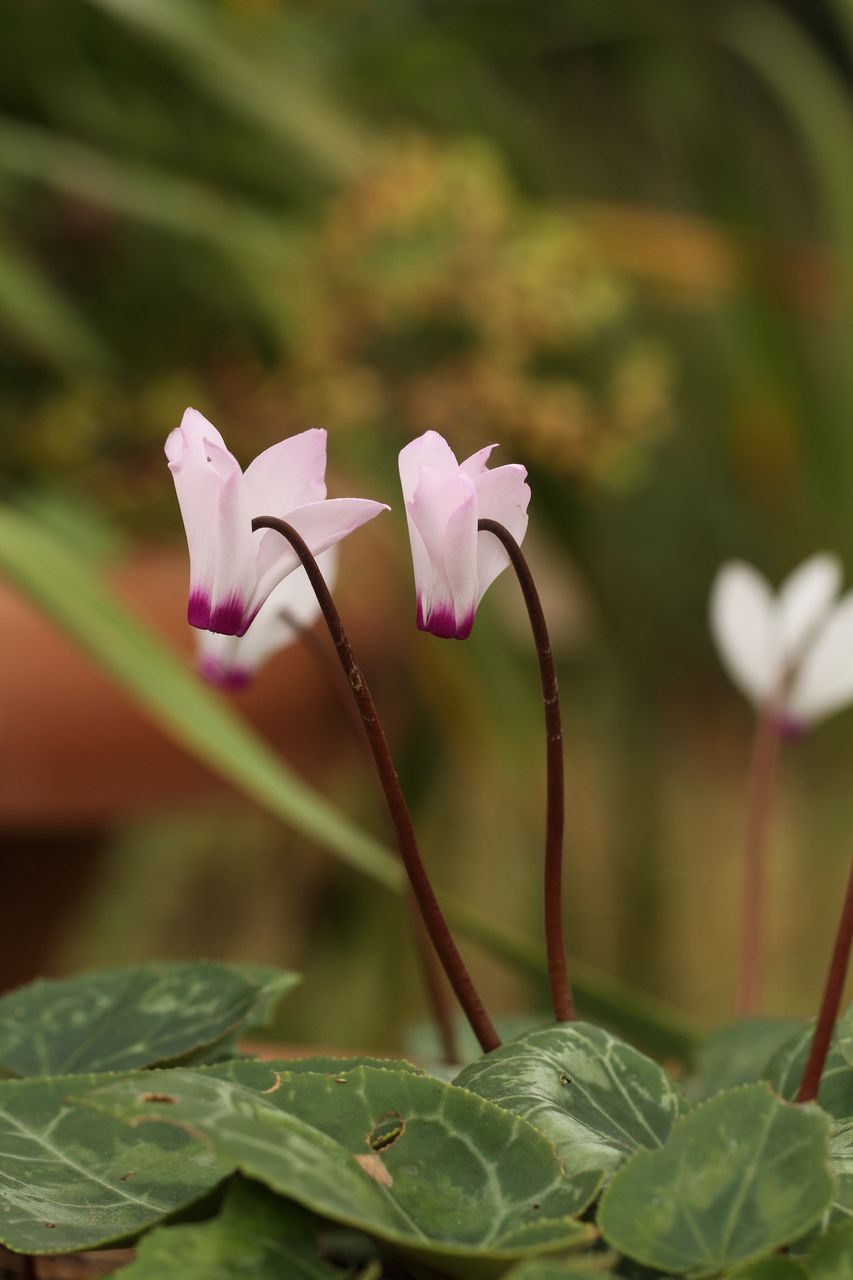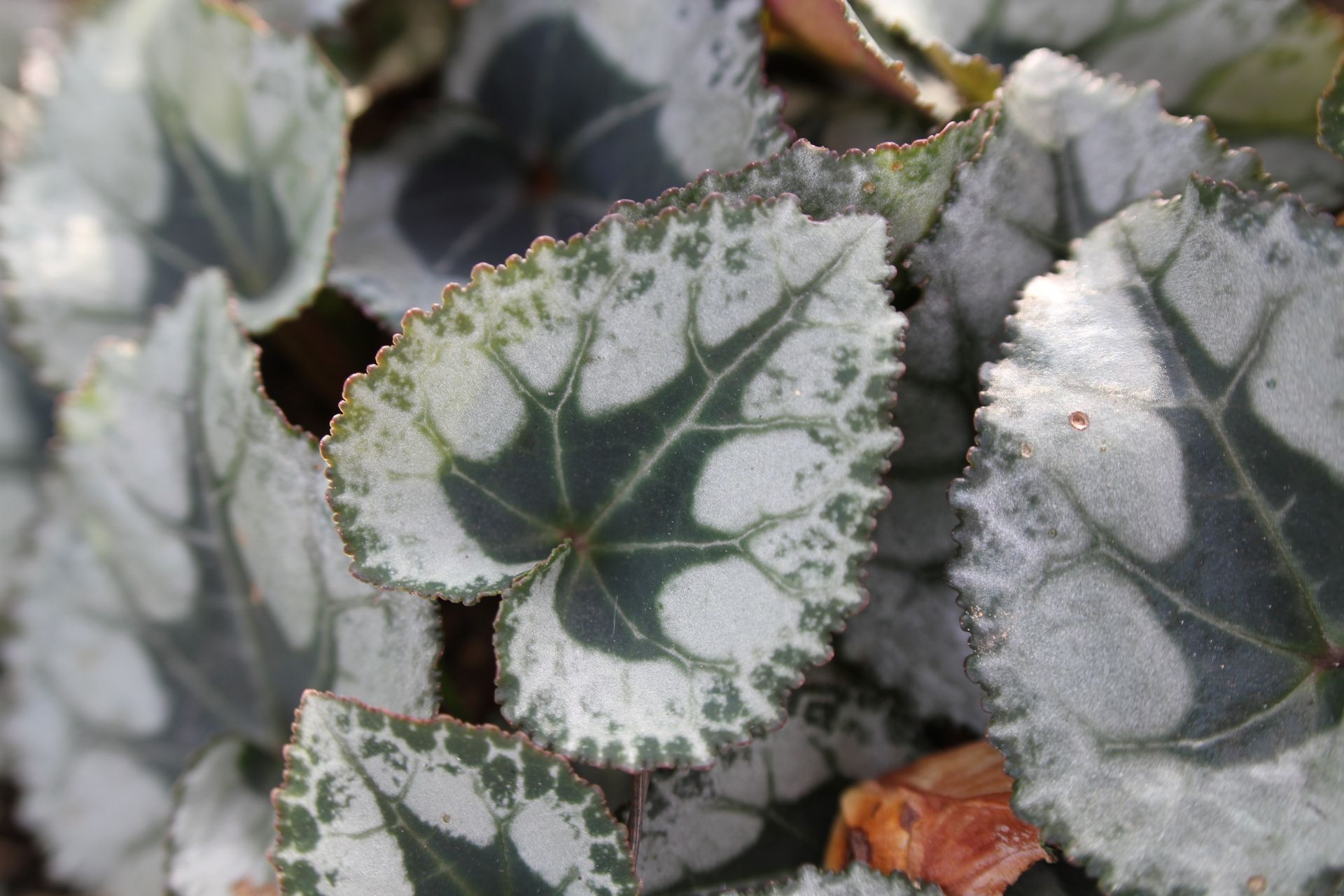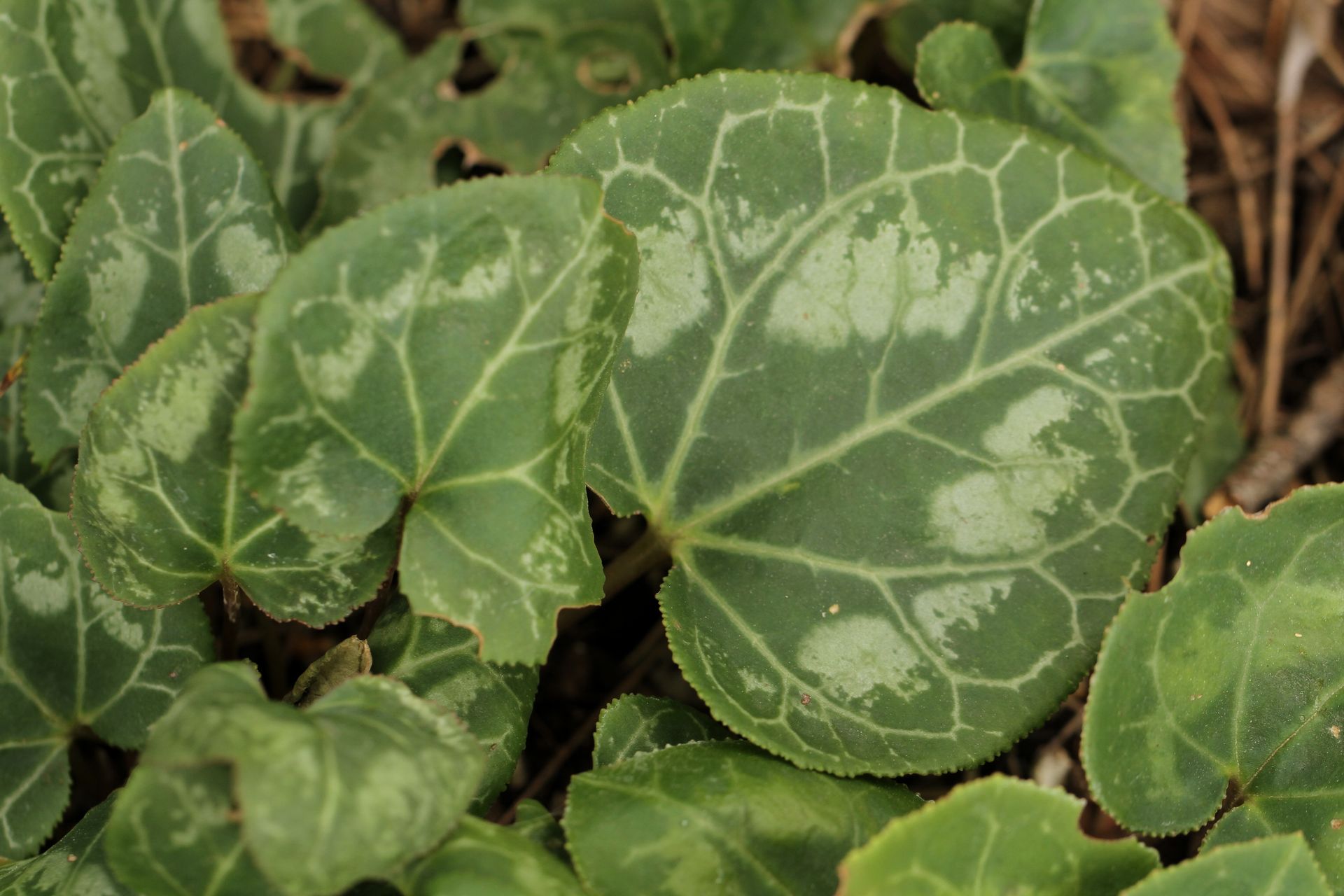Cyclamen persicum 284
Author: Philip Miller (1691-1771)Family: Primulaceae Subfamily: Myrsinoideae
Genus: Cyclamen
English name: Florist's Cyclamen
Zone: Mediterranean
Description
Cyclamen persicum has a wide distribution in the eastern Mediterranean region and North Africa. It has been recorded in northern Tunisia and Algeria, Crete, the Aegean Islands of Rhodes, Symi, Karpathos and Chios, the Athos Peninsula in northern mainland Greece, Cyprus, southern Turkey, western Syria, Jordan, Lebanon and Israel. In some of these localities, it is found on ancient sites and in graveyards, so this raises the question as to whether it is truly native or has been introduced for decorative purposes. It occurs in stony or rocky places, often in crevices, in open rocky maquis and garigue, often on limestone formations but not necessarily so, sea level to 1200m.

Cyclamen persicum Observed in Israel by Yuval (license)
Botanical Description
The tuber is rounded at first, becoming more depressed-globose with age, up to circa 15cm in diameter at maturity, brown, rough or even cork-like in old age, rooting from the underside, the roots thick but not markedly fleshy.
The petioles are erect from the tuber. The leaves are rather fleshy, well developed before flowering time. The leaf blade is broadly ovate, 2.5-18.6cm long, 2.5-15.3cm wide, green with very variable marbled pale green or silvery-green patterns and zones, sometimes predominantly pewter-colored. The margin is thickened with cartilaginous teeth. The underside is normally purplish suffused.
The pedicels are rising erect from the tuber, after anthesis not coiling but arching over to touch the ground. The flowers are produced in winter through to early spring or more rarely autumn, fragrant. The petals are swept upwards to an erect position, white to medium purplish-pink, usually with a darker pink or magenta basal stain around the mouth of the corolla, oblanceolate-elliptic with acute or subacute tips, 2-4.5cm long, 0.7-2cm wide, strongly twisted lengthways, without swollen appendages at the base. The style is slightly exserted from the mouth of the corolla.
References
- Flora of Turkey and the East Aegean Islands, P.H. Davies. 1984 Vol. 6 pag. 131. ISBN
- Genus Cyclamen in Science, cultivation, art and culture, B. Mathew. 2013 pag. 111-122. ISBN
The petioles are erect from the tuber. The leaves are rather fleshy, well developed before flowering time. The leaf blade is broadly ovate, 2.5-18.6cm long, 2.5-15.3cm wide, green with very variable marbled pale green or silvery-green patterns and zones, sometimes predominantly pewter-colored. The margin is thickened with cartilaginous teeth. The underside is normally purplish suffused.
The pedicels are rising erect from the tuber, after anthesis not coiling but arching over to touch the ground. The flowers are produced in winter through to early spring or more rarely autumn, fragrant. The petals are swept upwards to an erect position, white to medium purplish-pink, usually with a darker pink or magenta basal stain around the mouth of the corolla, oblanceolate-elliptic with acute or subacute tips, 2-4.5cm long, 0.7-2cm wide, strongly twisted lengthways, without swollen appendages at the base. The style is slightly exserted from the mouth of the corolla.
References
- Flora of Turkey and the East Aegean Islands, P.H. Davies. 1984 Vol. 6 pag. 131. ISBN
- Genus Cyclamen in Science, cultivation, art and culture, B. Mathew. 2013 pag. 111-122. ISBN

References for the genus
- A biological overview on the genus Cyclamen, Djeddi, Dr. Samah and Mazouz, Wissam. European Journal of Scientific Research 2013. Address
- A review of research on Cyclamen, Chris Clennett. Herbertia 2002 Vol. 57 pag. 27-36. Address
- Flora iberica, Santiago Castroviejo. 2010 Vol. 5 pag. 44-46. ISBN
- Flora of Turkey and the East Aegean Islands, P.H. Davies. 1984 Vol. 6 pag. 128-135. ISBN
- Genus Cyclamen in Science, cultivation, art and culture, B. Mathew. 2013 pag. 64-336. ISBN
- Hommes et Plantes. Vol. 92 pag. 5-11. Address
- A review of research on Cyclamen, Chris Clennett. Herbertia 2002 Vol. 57 pag. 27-36. Address
- Flora iberica, Santiago Castroviejo. 2010 Vol. 5 pag. 44-46. ISBN
- Flora of Turkey and the East Aegean Islands, P.H. Davies. 1984 Vol. 6 pag. 128-135. ISBN
- Genus Cyclamen in Science, cultivation, art and culture, B. Mathew. 2013 pag. 64-336. ISBN
- Hommes et Plantes. Vol. 92 pag. 5-11. Address

General specifications
Biological type: bulb
Frost resistance: 27ºF
Leaf color: dark green
Flower color: white
Fragrant: Yes
Indexed Species not necessarily threatened with extinction (Cites II) the Convention on International Trade in Endangered Species of Wild Fauna and Flora.
Specifications for the Mediterranean basin
Adult size (h x w): 0,6ft x 1,3ft
Sun exposure: shadow (Sun hours: <3h Foliage: deciduous in summer
Growth: fast
Flowering time from February until April
Ripe fruits in June
Specific information for our garden
Planting substrate: 30%Compost+30%Coco+40%Sand
Plant watering: Summer sleep pH 6.5
Logical sequence of containers for: Bulbs; 2L forestry pot, 1L container, 25L high container, 145L wide cup
Propagation is done by root division
Ecology in its country of origin
Rainfall: 400-800mm
Gravelly soil: much
Sandy soil: much
Limestone soil: much
Frost resistance: 27ºF
Leaf color: dark green
Flower color: white
Fragrant: Yes
Indexed Species not necessarily threatened with extinction (Cites II) the Convention on International Trade in Endangered Species of Wild Fauna and Flora.
Specifications for the Mediterranean basin
Adult size (h x w): 0,6ft x 1,3ft
Sun exposure: shadow (Sun hours: <3h Foliage: deciduous in summer
Growth: fast
Flowering time from February until April
Ripe fruits in June
Specific information for our garden
Planting substrate: 30%Compost+30%Coco+40%Sand
Plant watering: Summer sleep pH 6.5
Logical sequence of containers for: Bulbs; 2L forestry pot, 1L container, 25L high container, 145L wide cup
Propagation is done by root division
Ecology in its country of origin
Rainfall: 400-800mm
Gravelly soil: much
Sandy soil: much
Limestone soil: much

Sowing instructions
AUTUMN After harvesting the seeds, keep dry for 8weeks at room temperature then keep dry in the fridge at 4°C until sowing. Sow the seeds at 5mm depth in the Humic Bulb Substrate between 64-72°F. During germination keep the substrate moist and in daylight.
The viability of the seeds, kept under good conditions, is one year.
Germination references
- Seeds: Ecology, Biogeography, and, Evolution of Dormancy and Germination, Baskin, Carol & Baskin, J.M. 2014 pag. 1-1586. DOI
Germination references for the genus
- Effect of different chemicals on germination of Cyclamen seeds, Sevindik BaŇar, Tüücü Mehmet, Göbey AslıGüeŇ, Dügöen Berfin, Doygun Neslihan, Uğur Senem & Mendi YeŇim Yalçi. 10th International Molecular Biology and Biotechnology Congress 2021 pag. 21-27. ResearchGate
- Gibberellic acid can improve seed germination and ornamental quality of selected cyclamen species grown under short and long days, Cornea-Cipcigan Mihaiela, Pamfil Doru, Sisea Cristian Radu & Mrgoan Rodica. Agronomy 2020 Vol. 10(4) pag. 516. DOI
Bulb planting instructions
Plant the bulbs under 2cm Humic Bulb Substrate at 30cm distance. Plant between sept-oct.
The viability of the seeds, kept under good conditions, is one year.
Germination references
- Seeds: Ecology, Biogeography, and, Evolution of Dormancy and Germination, Baskin, Carol & Baskin, J.M. 2014 pag. 1-1586. DOI
Germination references for the genus
- Effect of different chemicals on germination of Cyclamen seeds, Sevindik BaŇar, Tüücü Mehmet, Göbey AslıGüeŇ, Dügöen Berfin, Doygun Neslihan, Uğur Senem & Mendi YeŇim Yalçi. 10th International Molecular Biology and Biotechnology Congress 2021 pag. 21-27. ResearchGate
- Gibberellic acid can improve seed germination and ornamental quality of selected cyclamen species grown under short and long days, Cornea-Cipcigan Mihaiela, Pamfil Doru, Sisea Cristian Radu & Mrgoan Rodica. Agronomy 2020 Vol. 10(4) pag. 516. DOI
Bulb planting instructions
Plant the bulbs under 2cm Humic Bulb Substrate at 30cm distance. Plant between sept-oct.

Experiences in the garden
02-08-16A Obtaining 3 plants from nursery Bulb Argence
21-06-18 3x Plant not found in garden: Rp2.
17-09-18B Obtaining 5 plants from nursery Nijssen Bulbs, they are in our nursery Petit26 4x V25
25-09-20C Obtaining 6 plants from nursery Libertos, they are in our nursery Petit1 6x C1
. . . 2022B Collection of seeds in the garden collected at 29-06-22.
30-09-22 Sown 30 seeds in a container 1L and germinated at 03-11-22 but the seedlings did not survive in Petit26.
Protocol: Autumn Fridge 2mm SBH 68-77°F Damp substrate+Light
. . . 2022D Production of 5 plants in our nursery: Petit26 5x V25 (Wild origin)